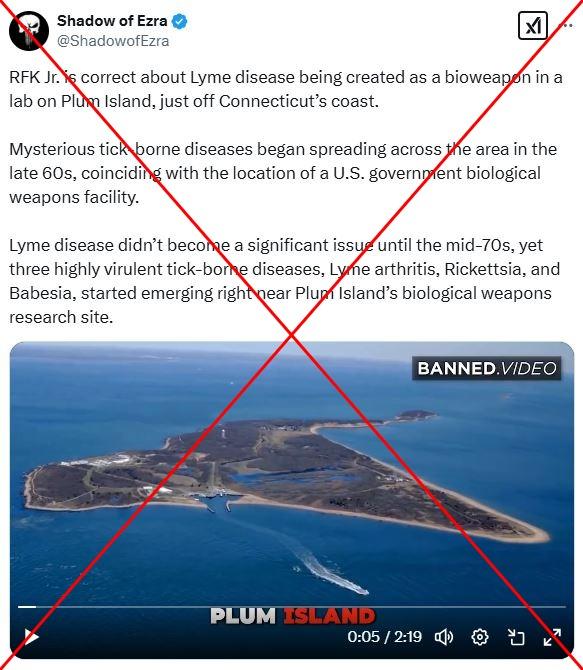
RFK Jr Senate hearing resurrects Lyme disease bioweapon conspiracy theory
- Published on February 5, 2025 at 18:14
- 4 min read
- By Daniel Patrick GALGANO, AFP USA
"RFK Jr. is correct about Lyme disease being created as a bioweapon in a lab on Plum Island, just off Connecticut's coast," says a January 29, 2025 X post from an account called "Shadow of Ezra," which AFP previously fact-checked.
"Mysterious tick-borne diseases began spreading across the area in the late 60s, coinciding with the location of a U.S. government biological weapons facility," the post, which accumulated tens of thousands of interactions, claimed.

The same claim has circulated elsewhere on X, Facebook. Instagram, Threads, TikTok and Rumble.
The conspiracy theory about Lyme disease originating as a bioweapon was popularized in a 2004 book titled, "Lab 257: The Disturbing Story of the Government's Secret Plum Island Germ Laboratory." The book speculated that scientists at an animal disease laboratory on Plum Island, located in New York's Long Island Sound, experimented with Lyme disease-infected ticks, which then escaped from the facility around 1975 and spread across the eastern United States.
In 2019, New Jersey Representative Chris Smith attached an amendment to a defense spending bill ordering the Pentagon's inspector general to investigate whether Lyme disease had originated as a bioweapon from Plum Island or another facility. While the text passed the House, it does not appear in the final version of the bill voted on by the Senate (archived here and here).
The Department of Homeland Security, which is in the process of decommissioning the Plum Island facility and moving operations to Kansas, says scientists at the lab "do not research, and have not researched, Lyme disease" (archived here).
Nevertheless, Kennedy devoted an entire episode of his podcast to Lyme disease in January 2024. In it, he discussed the Plum Island conspiracy theory and said the disease is "highly likely to have been a military weapon" (archived here).
"We also know they were experimenting with diseases of the kind, like Lyme disease, at that lab, and putting them in ticks and then infecting people, testing them with bird vectors, et cetera," he said on the "RFK Jr. Podcast."
During a January 29, 2025 confirmation hearing, Kennedy testified before the Senate Finance Committee, that he "probably did say" Lyme disease was a bioweapon. But the next day, he clarified in a hearing at the Health, Education, Labor and Pensions Committee that he "never believed" the disease was a military bioweapon and said that he had not finished the books that made those claims (archived here).
Millennia-old disease
Lyme disease is spread by ticks carrying bacterium called Borrelia mayonii and Borrelia burgdorferi (archived here). Swiss-American researcher Wilhelm Burgdorfer first identified the bacteria in 1982 (archived here).
Typically, the disease causes symptoms such as fever, chills, joint pain, muscle aches and fatigue, but it can spread to the heart and nervous system if left untreated (archived here). It was recognized as a syndrome in the 1970s after a string of infections, but scientists have found evidence of Lyme disease existing in North America as long as 60,000 years ago (archived here).
In 1994, researchers also found evidence of the bacteria that cause Lyme disease in taxidermied animals collected between 1870 and 1919, decades before the Plum Island laboratory was established (archived here).
Burgdorfer did give an interview that implied Lyme disease's spread could have been the result of a failed biological weapon experiment. However, it was late in his life, and he was reportedly suffering from late-stage Parkinson's disease at the time (archived here).
"Absurd"
Durland Fish, a professor emeritus of epidemiology at Yale University who worked at Plum Island in the 1990s (archived here), said the laboratory could not perform research on diseases like Lyme disease because it did not have adequate containment facilities or protective gear to shield employees from contracting diseases that could pass to humans.
Fish, who worked with Burgdorfer when he was studying Lyme disease, also said interviewers "misinterpreted" the Swiss scientist's statements about the disease and that there is no evidence it was manufactured by humans.
"Willy was not in his best mental health at that time, and there's absolutely no truth to the accusations that he was involved in any kind of biowarfare activity," he said on February 4.
Fish said Lyme disease would not make for an effective bioweapon, both because it is primarily spread through tick bites and can be treated with antibiotics.
"It's absurd to think that something like that will be used for biowarfare," he said.
Bryon Backenson, the director of the New York Department of Health's Bureau of Communicable Disease Control (archived here), said there is "no evidence" Lyme disease was materially engineered by humans or artificially introduced into the environment. He said there are records of Native Americans contracting the disease, which some called "Montauk knee," hundreds of years ago.
The relative secrecy of the research at Plum Island spawned multiple "sensationalist" theories, Backenson said, including that it is the birthplace of Lyme disease because of its relative proximity to the Connecticut town of Old Lyme, which is where some of the first cases of the disease were diagnosed. However, he said the ailment would move too slowly to ever serve as a useful military weapon.
"Lyme disease is spread by the bite of infected ticks, requiring the tick bite for entry into humans. Because of this, it is believed to be a poor choice for a bioweapon," he said in a January 31 email.
Copyright © AFP 2017-2025. Any commercial use of this content requires a subscription. Click here to find out more.
Is there content that you would like AFP to fact-check? Get in touch.
Contact us
